#baby cochin chicks
Explore tagged Tumblr posts
Text
Chickpocolips Survivors #Shorts
Well, not tiny. They’re four weeks old. And I’m pretty sure two of them are splashes and one I don’t know. It’s like a blue gray kind of like these gray females right here. Anyway, there’s my chick flick… There’s another video of the day. Want to watch the whole video? https://youtu.be/rDvNnRqGvXg 🙏 Subscribe, 👍, it helps a lot!!➤❓/ 💬: [email protected] ➤➤I get a little for the…

View On WordPress
#baby chicks#baby chicks chirping#baby chicks cute#baby chicks fighting#baby chicks growing up#baby chicks peep#baby chicks playing#baby chicks videos#baby cochin chicks#baby polish chicks#baby silkie chicks#chick development day by day#chick development stages#Chickens For Chicks#chicks chirping#polish chicks#polish chicks growing up#silkie chicken#silkie chicken growth stages#silkie chicks care#silkie chicks growing#silkie chicks week by week
0 notes
Note
Hi! 😁 I might soon have the chance to have a garden and I've always wanted to have a few chickens, and I've started some online reasearch about keeping chickens but since you're an expert and I don't trust some of the online sources, do you have any tips for absolute beginners? 😅
I do! You can have a garden, or you can have chickens, but the two are diametrically opposed forces that do not coexist peacefully without fully enclosing one or the other. Chickens can and will obliterate gardens and landscaping if they have access to it, including absolutely destroying mulch patches by helping you spread it all over the yard.
I'll put the rest under a cut ^_^
When you acquire chickens, don't get them from a hatchery, get them from a small breeder you've looked into and spoken with about their actual birds. Hatcheries have poor quality animals, so while you may be getting a "black copper marans," they're not gonna necessarily look very nice, and they're almost certainly not going to lay that nice, deep chocolate marans are known for.
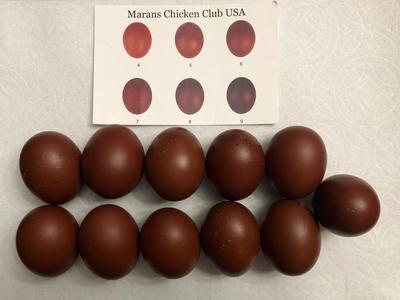
Vs straight from one of the bigger hatcheries pages, photos of their eggs:

You also are NOT going to get the breed qualities of any given breed except maybe some of the production breeds. For example, a Jersey Giant from a reputable breeder will get up to 10-13lbs, which is as big or bigger than my peafowl. Same with Brahmas and Cochins. Hatchery stock you will be lucky to see 6-8lbs, and people are OFTEN disappointed about this kind of thing. Silkies, as another example, can look WILDLY different from a hatchery vs a private breeder. A show quality silkie is a puffball:
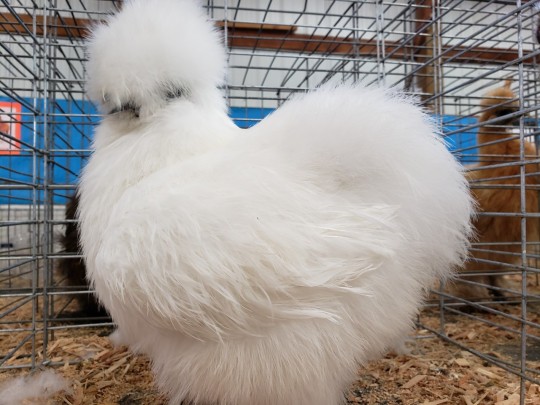
Hatcheries also pull skeevy moves like calling easter eggers (mutts that lay blue, green, pink, brown, or white eggs) "americanas" hoping that you mistake it for "ameraucana" the pure breed that lays stark blue eggs. Then they charge you ameraucana prices (like, $25/chick) when they should be charging more like $3-5 a chick. They'll do things like call a marans/barred rock mix a "mystic marans" as if it's a new color morph of a marans chicken instead of a mixed breed mutt they invented to be able to sex their chicks at hatch easier. People get these guys expecting MARANS eggs, and they get tan barred rock eggs. Same can go for temperament and behaviors. You go anywhere that has a group of chicken owners and ask them what their favorite breed is, you will get a range of answers with reasons like "my X is so sweet" while the next person will go "mine's the devil" and if you ask, 9 times out of 10, it's hatchery stock birds. Well bred private breeders often have MUCH more stable temperaments.
vs hatchery stock
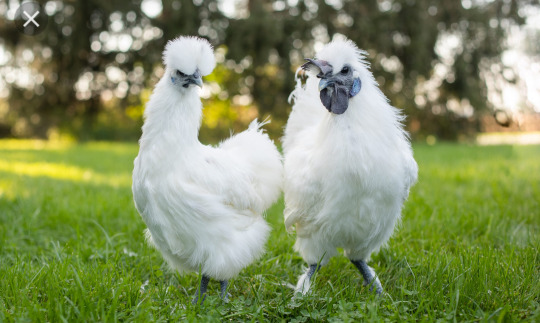
Getting from a private breeder also lets you get eggs, which can help you dodge a LOT of disease bullets. There's very little that transfers through the egg, strangely, and some of that is transferred on the surface of the eggs (like mycoplasma) so a quick santizing dip before incubation gets rid of that. I know that hatching them yourself is more of a hassle, but so is losing your flock to newcomers that came in with something entirely avoidable if you'd hatched instead. If your breeder is NPIP certified, they're getting tested for the major egg-traveling problem (pullorum) and a dip will take care of most anything else unless you're super SUPER unlucky.
Lastly on acquisitions, be prepared to get roosters. If you can't have roosters, be prepared to get them processed for yourself for food, or let the roosters go to food homes. Please please please please. There are so many, many excess roosters. They cannot all go to homes. The rooster to hen ratio in a flock is like 1:9. The rooster to hen ratio in hatching is nearly 1:1. Let someone make use of them. EVEN if you order from a hatchery, and order all pullets, they can make mistakes and send rooster babies. It's not a guarantee! Have a plan in advance! Mentally prepare yourself! Don't be one of Those People making posts in local groups about how you don't want/can't have this rooster but also no one else can eat it either. Chickens are a lot of things. Sometimes food is one of those things.
BEFORE actually acquiring the chickens, locate a vet that will see them. You are GOING to have an issue at some point in their lives, and that's not the time to start looking for a vet, that's the time to already have a vet on hand. In fact if you can support a yearly wellness check on at least one of the birds to test for communicable illnesses (like mycoplasma) and have a good relationship with your vet in advance, that's even better.
As for care, if you plan to contain the chickens, the minimum recommendation for a backyard coop and run varies wildly. For stress purposes, most chickens will find 4 feet of floor space per bird inside the coop adequate, accompanied by 10 square feet of space in a run per bird. Unlike peafowl, it doesn't matter how big the run is, the chickens will be turning the entire thing to bare soil, which is one of the reasons most people don't keep both in the same pens. I literally attempted to keep 2 standard chickens in a 1200 foot pen and they systematically went about destroying everything they could get to.
Most layer feeds are 16% protein; most layer feeds are also /production/ layer feeds, meant to feed production breeds in a space where they get NO other feed except this. If you plan to feed anything other than layer feed to them, like treats or whole foods or scratch grains, then you need to find a higher protein feed for them, because most treats are lower protein than layer feed. Avoid anything produced by Purina or Dumor (which is purina but TSC brand), except MAYBE the organic dumor 5-grain scratch grain, it's well-known as one of the worst quality fowl feeds out there. Check out your local mill and see if they have any options that are better than the big box farm stores. Kalmbach makes good feeds, as does Belstra.
Possibly counterintuitive, but stick with a smaller waterer over a larger waterer. You can keep a larger one around for if you go away for the weekend or something to make it easier on a sitter, but a smaller waterer like a 5-quart or gallon waterer will be easier to clean and make sure that you're giving fresh water more often, plus avoiding mosquitoes growing in it. Waterers can slime up really easily in the summer, so just be prepared to give it a quick swish clean every time you change the water out. Smaller waterers also make it easier to give them medication if you have something that goes in the water, especially since a lot of the water medications are "make fresh daily." Personally I don't bother with heated water bases anymore in the winter, I just have enough waterers to exchange them for a fresh one a couple times daily, while the old one thaws inside the back door on some plastic. The galvanized ones you have to use with the heated bases always got gross fast, with rust and discoloration and the stopper in the bottom always dried out and eventually cracked over the summer when we weren't using them.
Try to avoid straw bedding unless you REALLY trust the source. Straw is mostly for livestock, not poultry. It cannot catch the droppings of poultry the way shavings or sand or other beddings do, meaning the wet gunk drops to the floor under it and/or collects into grossness. It also molds easily, can carry in field parasites (since it's not treated the way shavings are often kiln fired before packaging), and breaks down into shards. I'm not saying you can't ever use it for any reason (I use it in some fashion, and have for over a decade, but not exclusively, and I trust my source, we've never gotten mites or anything, and I'm very careful about which bales I pick out), but if you have a choice, go for the wood substrates, or even for sand. A lot of people put sand in their runs because they can then rake it like kitty litter.
Look into what plants chickens can't have, and check your yard over thoroughly for them before adding chickens. Things like lilac bushes are toxic to them. Tomato and potato plants are nightshades so while they can have the fruits, the leaves and stems can be toxic. Stuff like that.
Lastly.... if anyone ever makes a claim about what something does for a chicken (example: diatomaceous earth, apple cider vinegar, pumpkin seeds, oregano, red pepper flakes, lavender, etc are all things I've seen people claim do all sorts of things from worming birds to curing respiratory infections), ask them for their source. If it's a blog post, ask them for a scientific article. If they can't provide it and you can't find one that backs up what they're saying, maybe reconsider the value of that particular advice. The thing is, the BIG production companies are VERY invested in finding cheap or organic or tricky ways to do WHATEVER it is (treat endo/ectoparasites, treat illness, make bigger or more eggs, change egg yolk color, etc), and they pour money into trying to figure out which old wives tales actually work and which ones don't. And if they haven't been able to prove it to a point where they'll spend money on it as a solution, then chances are REALLY GOOD that it's not a solution at all actually.
Things like how to clean coops, what feeds to get, what items to use for care, where to source birds, behavioral information etc, that's all stuff you can ask advice on in general public spaces. You'll still get a range of answers, and some of them will be garbage answers, but hardly any of them will do harm to your animals to do or not do. Like, for example, you can use a big waterer or a small waterer, as long as it's clean. You can vary coop and run size and still be fine. You don't have to feed exactly what someone else is feeding for your birds to be fine. You're probably going to try a few breeds before you find the one(s) you like best.
But when it comes to medical info or any kind of "treatment" type stuff? Consult a vet and/or at least look for scientific papers.
And lastly.... chicken math is Real, yo. However many chickens you think you want to get, plan on having the space for double that amount so you don't gotta rebuild anything when you ultimately decide wait, you need a couple more. The bigger space won't hurt them if you don't get more, but it'll be so much easier on you if you do ;)
227 notes
·
View notes
Text

Two chicken pens put together. My bantam cochin (hopefully) lavender carriers have technically BEEN together, but shh.
These are the sussex/cochin cross trio. Their eggs are either getting eaten or hatched on site, and no chicks will leave the property. I will only be keeping a couple mille fluer patterned chicks with feathered legs. Which I said is ... 9%? probability per chick.
I am SO excited to start getting eggs from these girls and hatch babies.
4 notes
·
View notes
Text
Brace Yourself for Cuteness
June 13, 2024
Yes, we have chicks! Daisy went broody and we haven't had chicks since the pandemic and we already traveled a lot this spring - so we said - "why not, let's go for it." And off we went to the Tractor Supply store to pick some out. Five of them, $2.99 each. We brought them them home in a little box and kept them warm until dark. And then slipped them under the sleeping Daisy.
They were installed last night and so far she's taken to it like a duck to water! They are still locked in the brooder, I'll let them out tomorrow, but the brooder roof comes off so we peek in - CUTE! Little heads poking out everywhere from underneath her. Daisy is not pleased that we are peeking, but doesn't growl at us - just puffs up REALLY big. I think that she thinks the growling might scare the chicks?

Daisy puffed up when I opened the door to take a peek!
Some other fun things - the brooder (which is a converted dog house), is set up with two rooms - one smaller one as a nest box and a larger one for eating and playing. Faithful readers will remember that we built the brooder during the pandemic when Melly (of blessed memory) went broody. It was in April and it was cold out and Melly used the brooder as intended. Daisy, however, as faithful readers know, is a Brahma hen, which is to say she is huge.
From the Livestock Conservancy
In 1843, the Chinese signed a treaty that opened all their ports to trade. Once the ports were open, many previously never seen landrace chicken breeds became available – some from the northern part of the country and some from surrounding port cities. Included were extremely large chickens with feathered shanks and toes from the areas near Shanghai. The ships took all types of cargo, including these unique chickens for meat and eggs on their return trips. The surviving birds were often given exotic names and sold for profit at their ports of call. . . .
Early Brahma chickens were first shipped to America and then to England. This breed, together with the Cochin, fueled what became known as “Hen Fever” – a national obsession for poultry that hit both America and England around 1850.
Super digression, but really interesting, visit the website for more Brahma Chicken facts! Anyhoo - to get back to the brooder, chicks and Daisy. I think she's too big for the nest box room. Last night - during the transfer - we took her from the coop, where she was brooding on the floor by the people door - and put her in the nest box part of the brooder. The idea is that she goes to sleep wishing for chicks and wakes up with chicks! It worked, except that she roused herself just enough to move to the bigger room. I moved her back and she moved back. We left it at that. This morning she had the chicks herded into the nest box area, where she stood guard (well sat) in the entrance to the other side.
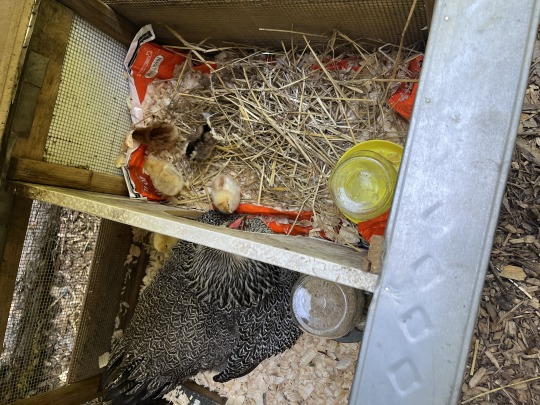
My idea now is to take out the divider and give them one big room. But that involves using my drill, which makes a lot of noise and might scare the babies so I'll save that for another day.
And here are some more pictures, because really - that's all anyone wants anyway!



Top: Guarding the entrance to the big room; bottom: chick escapes - well, the food is in the big room, so maybe she is letting them through so they can eat. The water is in the nest box room.

This may be the worst picture of me ever, but it shows the brooder, so there is that. The brooder roof is held on by pegs at the corners. I have wing nuts for the pegs, but I'm not sure why I though that was necessary. I would think it would be impossible for an animal to lift it off - it's hard enough with hands!
gtg, more chicken cuteness tomorrow! If you're in the area, come by and bliss out! But brace yourself. It's cuteness overload.
xoxoxox Sarah, who can never have too many chickens.
ps. How do the other girls like this? They are excluded from the brooder area - which is the little brooder and a run. So, we don't know yet.
0 notes
Photo
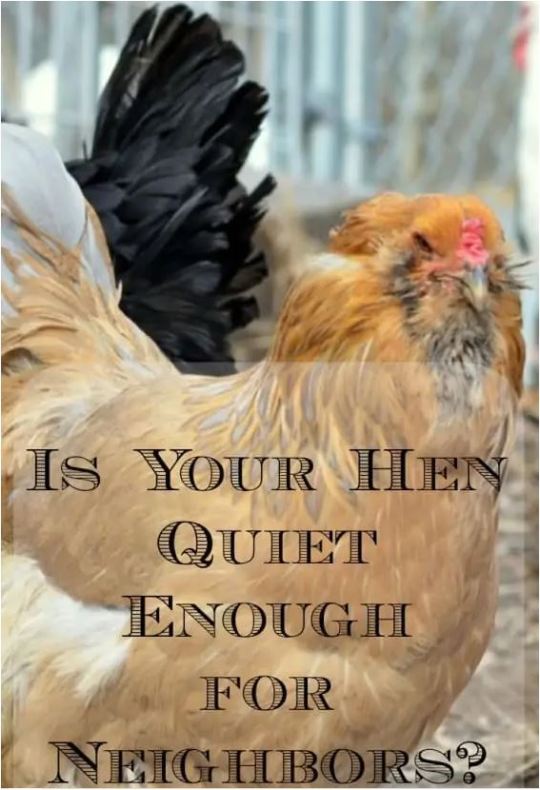
Want to Raise Chickens Near Town? Consider Quiet Chicken Breeds:
Chickens are easy and fun to keep as an alternate natural food source (meat and eggs), pest control, companionship, entertainment, fertilizer for a garden, source of income and bartering resource. Chickens are inexpensive to initially purchase and raise. They are friendly, easy to manage and low maintenance. They reproduce quickly, don't need a lot of space and stay near the coop, and, pretty much take care of themselves. Quiet Chickens: When you are raising chickens in your backyard in the suburbs or even in a small town, there is only one thing as important as egg quality when deciding what breed of chickens to raise – how much noise they make. Quiet chickens breeds do exist, and you do not have to sacrifice egg quality to raise them! If you don't want angry neighbors pounding on your door or stopping you in the driveway over the constant chatter of your beloved flock, invest in a breed known for its polite demeanor. Free-ranging breeds do not need “boredom busters” to keep the content, laying, and playing nice with one another. When allowed to roam at their leisure, the birds are both physically and mentally stimulated and simply don’t feel the need to carry on and make a bunch of racket. A free flock is also usually a healthier flock because they are adhering to their natural instincts and selecting big juicy bugs out of your yard to feast upon – and reducing your feed bill in the process. Noisy chickens in a run might have as much to do with the space and the environment as it does the breed. The general rule of thumb is the taller the coop and run, the happier (and quieter) the chickens will be. Quiet Chickens – What Breeds to Choose in the Suburbs [Article 3]
Rhode Island Red (invest in heritage breeds instead of commercial breeds)
Orpington (come in various colors like Black, Blue, White, and Buff (tan) and 2 sizes, regular(Large) and bantam)
Java
Bantam ("Banties")
Wyandottes
Cochins
Brahmas (massive size, can grow to hit weights of up to 14 pounds)
Speckled Sussex
Australorps
Barred [Plymouth] Rock
Mottled Java (currently on the Livestock Conservancy listing as in danger)
Ameraucanas
Salmon Faverolles
Polish chicken
Leghorn
LESS ROOSTER CROWING: Silkies and Phoenixes
Roosters are the noise-makers. One of the most popular misconceptions about chickens is that a Rooster is needed for chickens to lay eggs. Not so; chickens will lay eggs without a Rooster. The only time a Rooster is needed is to expand the flock (baby chicks). They are also the protectors of the flock from predators. Egg Laying: Another misconception is that a nest is needed for a chicken to lay eggs; many chicken breeds (do your research) will lay eggs anywhere, anytime with or without a nest. I've found them just laying on the ground in the chicken run. So, unless you want to go egg hunting for your next omlet, keep them in a coop and penned in area. Encouragement: Raising livestock and cultivating a garden are great activities to become more self-sufficient, less reliant on commercial products and staying in touch with nature. If these activities are not for you, please consider supporting your local farmers instead of the grocery store. Related Resources: Storey's Guide to Raising Chickens by Gail Damerow on Amazon The Chicken Encyclopedia by Gail Damerow on Amazon Benefits and Tips for Raising Chickens: My Adventure Methods to Preserve Washed and Unwashed Eggs Long Term [Author's Reference Link]
[11-Cs Basic Emergency Kit] [14-Point Emergency Preps Checklist] [Immediate Steps to Take When Disaster Strikes] [Learn to be More Self-Sufficient] [The Ultimate Preparation] [P4T Main Menu]
This blog is partially funded by Affiliate Program Links and Private Donations. Thank you for your support.
#chickenRaising#ChickensQuiet#food#prepper#survival#diy#shtf#quietChickens#suburbChickens#eggsWashedUnwashed#chickenEggs#homesteading#prepping#preppers#survivalist#survivalism#prepared#chickens#raising chickens#chicken eggs
0 notes
Text
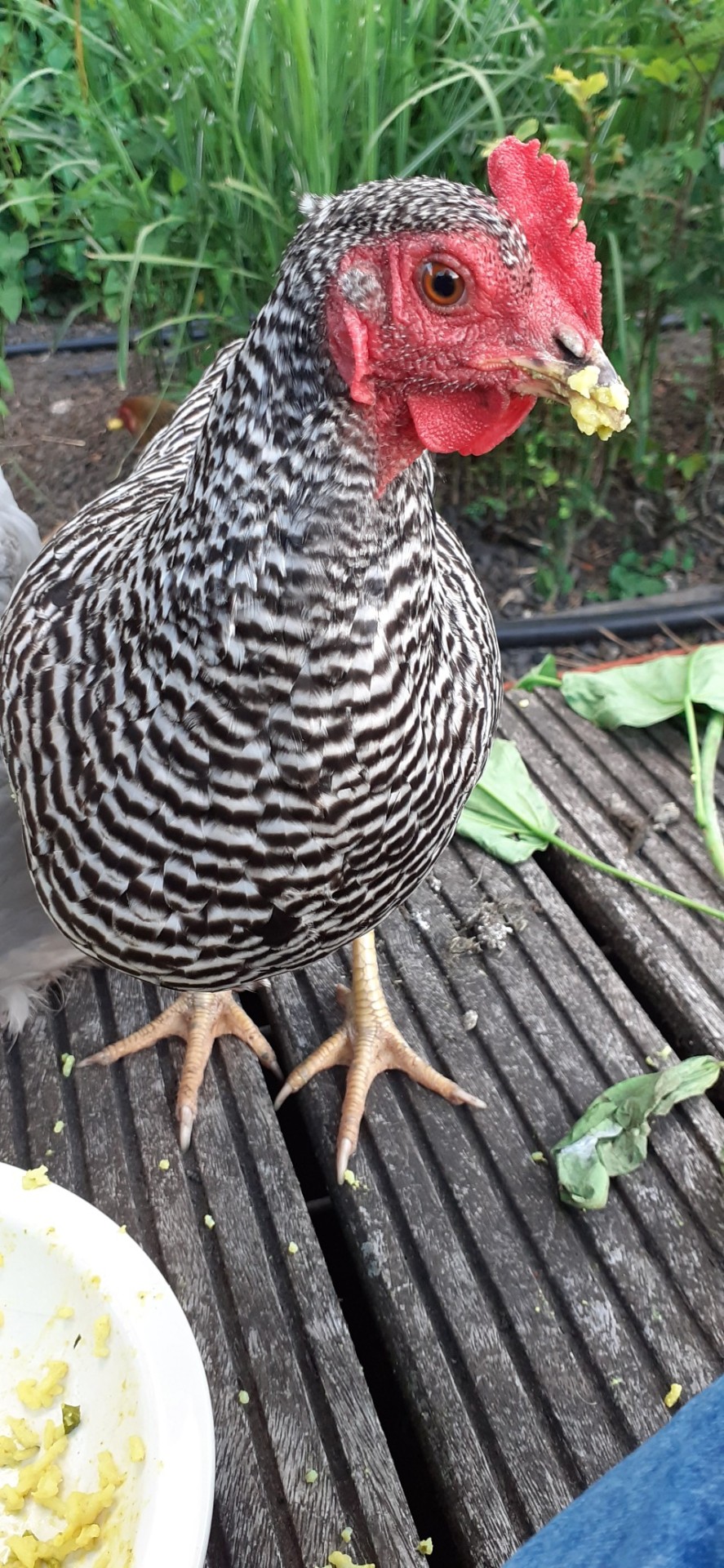
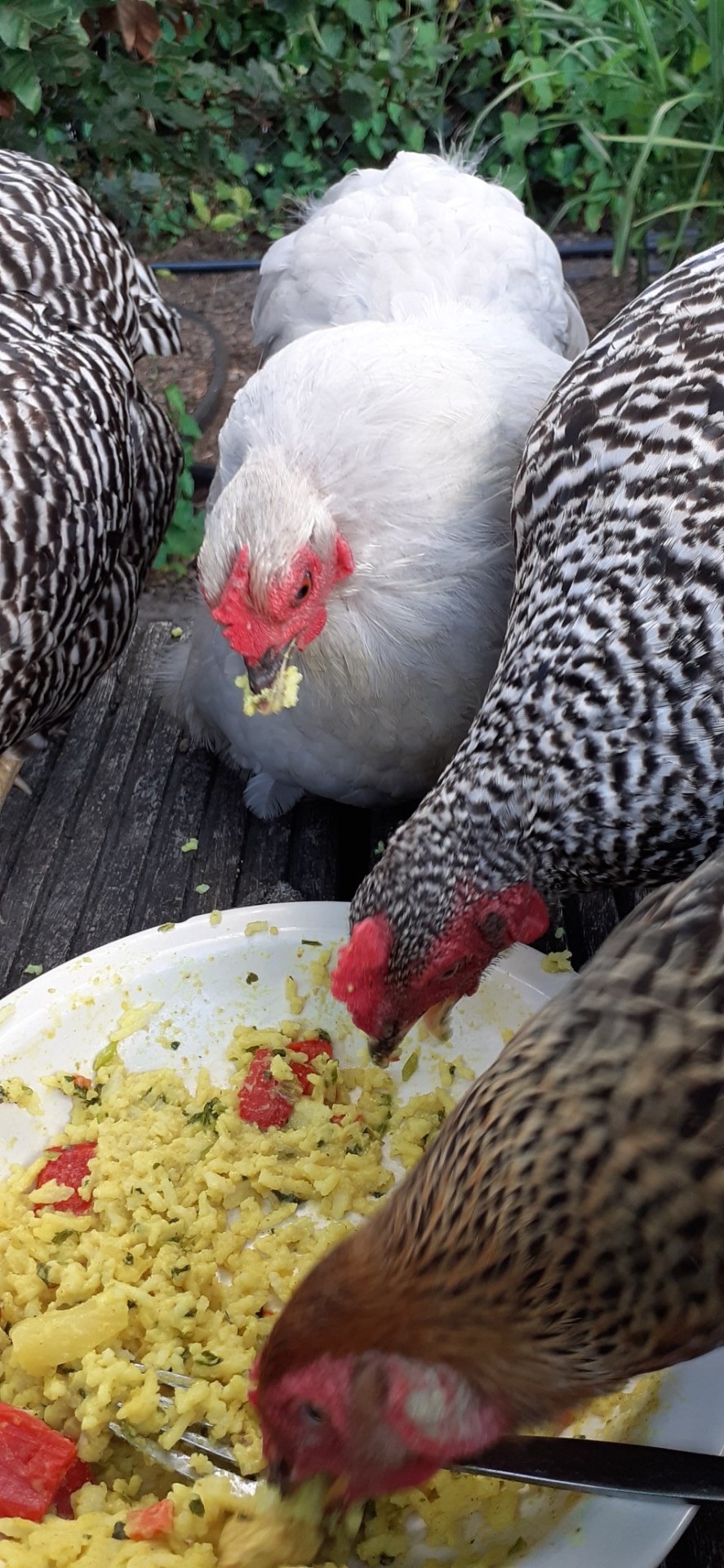
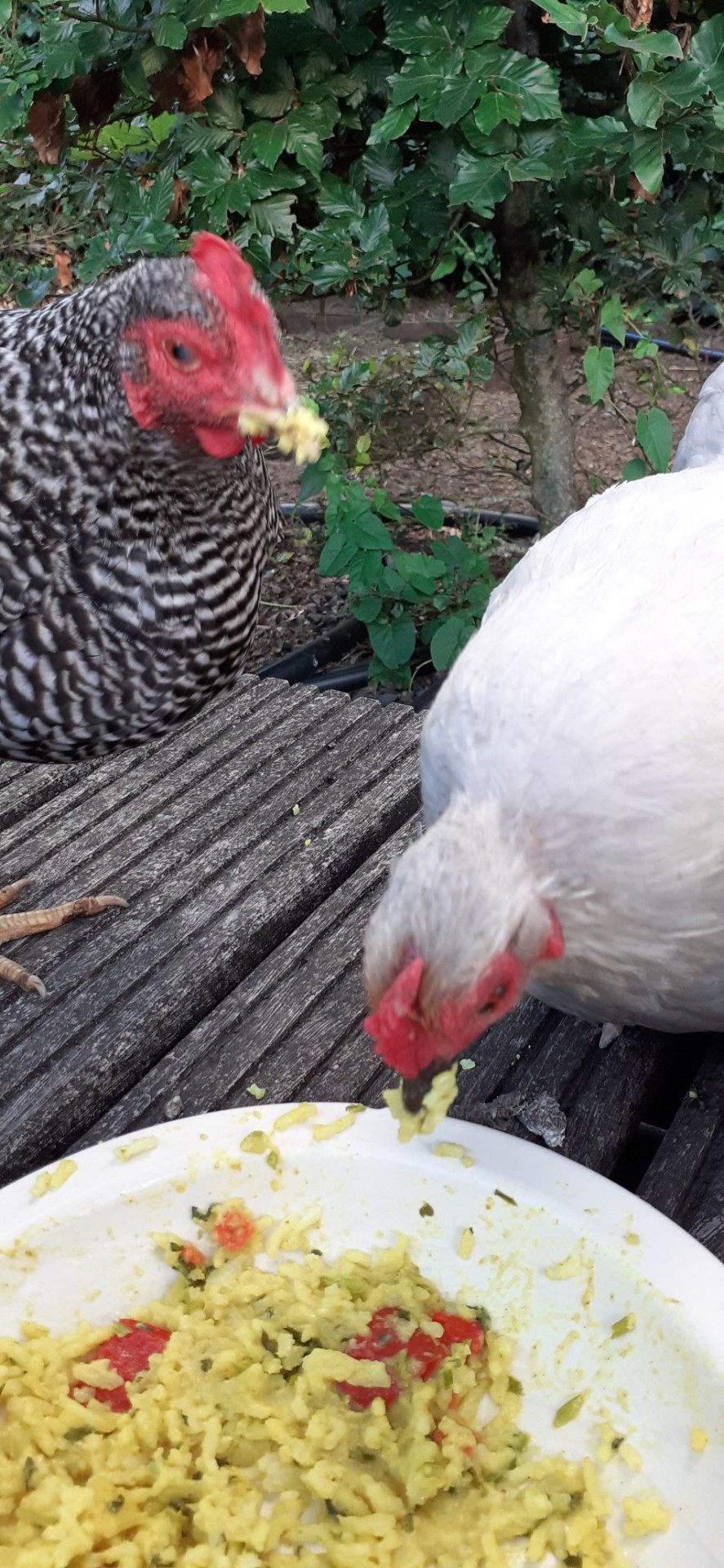
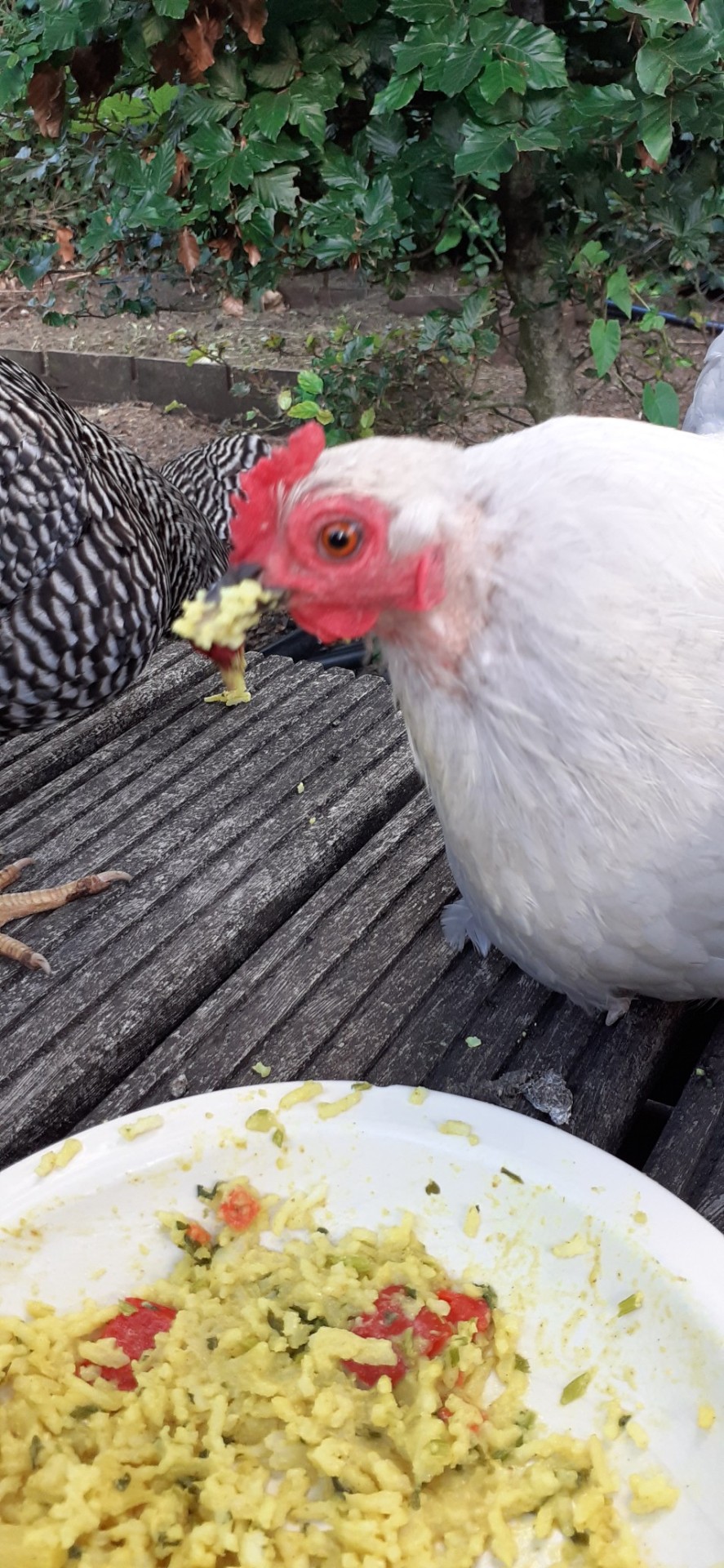
Absolutely lost in the sauce
12 notes
·
View notes
Text
Welcome to "Rating One Day Old Infants"
1. Dirt Boi

Either pure Russian Orloff or Orloff x Barnevelder.
6/10 - Fearless but doesn't like me. Sassy af. Big. Calling it that this is a roo.
2. Leggggg

Russian Orloff x Jersey Giant
10/10 Sweet smol tol thing. A little frightened sometimes but aren't we all? Hoping this is my favorite hen's biological baby. Overall cutie pie. Pullet?
3. Tiny Eyebrows

Russian Orloff x Jersey Giant
8/10 Solid beast. Standard chicken creature. Guessing roo.
4. Cryptid i.e. Pants 2.0

Russian Orloff x Cochin
-3/10 Cannot get a clear photo. Exists but doesn't know it. Pullet?
#chickenblr#backyard chickens#baby chicks#baby chicken#russian orloff#jersey giant#cochin#barnyard mix chickens#baby animals#animals#all roo pullet guesses arent based on anything but gut feeling lol
491 notes
·
View notes
Text

little Icarus has gotten so fluffy!
#love these curly babies#chickenblr#chickens#my chickens#photo#icarus#bantom#frizzle bantam cochin??#birblr#birdblr#chicken#chicks
39 notes
·
View notes
Photo

STICKY CHICK Was stuck to egg membrane
Chicks are hardwired to struggle. It takes strength and perseverance for the average chick to get out of its shell. The little thing on the tip of it's beak is an egg caruncle or egg tooth. The chick breaks a hole in the shell, and then using the egg tooth, they cut a circle around the egg and pop off the end to crawl out.
It takes hours to do and they nap in between.
Humidity at this point is crucial, high enough to soften the egg, not high enough to drown the chick. This poor little thing got stuck to the egg membrane when the humidity dropped (side effect of living in a desert) and it struggled for nearly 24 hours before I realized what was going on and helped to free it. I had to bathe it in hot water to get the stuck shell off of it. Helping is a big no-no but sometimes you can't just let them die.
Recovery has been slow, as of yesterday I was still holding the chick up to drink water and it wasn't eating. At hatching they have absorbed a few days egg yolk to survive and that kept it alive. Still, I've been worried it would die. But life is scrappy sometimes and this little one turned a corner this afternoon and is doing much better today. Eating, drinking and starting to run around with the other chicks. It could still could take a downturn, but I'm hopeful for the first time.
Cute little thing, very fuzzy, with feathered feet. Curious to see what it will look like as an adult, should it make it that far. Fingers crossed.
These are hatched shells below, you can see how the chick cuts around the egg, and in the two at the bottom (especially) you can see the shell membrane. The chick grows inside the membrane which lines the shell, then climbs out of both to hatch.

#chick#chicken#hatching drama#scrappy baby#sticky chick#farm life#backyard chickens#backyard farming#©teenytinydinosaurfarm#backyard flock#los angeles#california#cochin mix#feathered feet#cute#little#adorable#struggle#easter eggs
36 notes
·
View notes
Text
so I guess we’re also keeping angry goth chickens now
#birdblr#silkie#cochin#chickenblr#[ silkie x cochin crosses I think?#am no chicken expert ]#[ poor things are a bit scruffy still ]#[ we rescued them from a family who got the baby chicks in order to ‘teach’ their children about natural life cycles ]#[ then got overwhelmed when the babies grew bigger - they have been rearing them in a box ]#[ like guys#if you wanna educate your kids - just bring them to a petting farm ffs ]#[ on the funny side - I kinda feel like naming them all Sasuke 1 2 3 4 & 5 ]
4 notes
·
View notes
Text
Chick Flick Polish, Cochin & Silkie Chicks July 27, 2022
Chick flick of the day. Decided to give the mushy fermented stuff to the babies. The liquid is supposed to be good for them too. ⏱️⏱️Chapters⏱️⏱️00:00 Giving fermented feed00:20 Trying to get everyone outside00:30 Don’t know why they go after just one bowl01:25 So excited I have babies hatching02:25 Think I’ll use the trough feeder next time ???? Subscribe, ????, it helps a lot!!➤❓/ ????:…

View On WordPress
0 notes
Text



My baby chicks when they arrived. I had to order 25, and the hatchery threw in a freebie. Sadly 4 of the chicks passed away, so I still have 22 chicks. I am not entirely sure which babies I still have left. I will post more as they age.
#baby chickens#chicks#baby chicks#red star#Egyptian Fayoumis#Whiting True Green#Whiting True Blue#ameraucana#Light Brahmas#Silver Spangled Hamburgs#White Cochins#homestead#homesteading#farming#egg layers
4 notes
·
View notes
Text
More chicken rambling. Because the chickens are doing a hell of a lot more good for my mental health than the rabbits. I'd like to figure out breeding pens now.
First and foremost, I know that I need a pen of buff laced project birds. Which will either be one partridge cochin roo over both buff laced hens, two buff laced roos over two partridge hens, or ... I haven't figured out exactly what I want to do if I get a wyandotte hen and a roo.
I'll be culling out a LOT of partridge chicks at some point this year for toe feathering, which I think they're inheriting from my current partridge roo. Which means he needs to be culled out, too. I have one partridge cockerel that looks to have better feathering than his sire, but there aren't a whole lot of them overall despite the sheer number I've hatched out. That's probably going to be all that I can cull them for this year, however.
I want to put my current partridge hens under my black roo this year, too. I stupidly let them out with the main flock, which includes my bantam roos, so I might hatch out some weird ass things, too, for a minute. But if I can get some black split to partridge chicks with feathering and *soft tail feathers*, I would be ecstatic. So for next year, the partridge plan would actually be to breed THOSE chicks together. A trio or a quad, I dunno. I haven't even paired these chickens up to make these chicks yet.
I also have hatched zero blue things out of my blue laced red wyandotte hen this year, so I want to put her under a partridge roo next year again. Get more blue laced red cochin crosses. I do have a boy out of her with a single comb, so if I could keep a couple blue things with single combs, that would be great. But next year, she's just paired up all alone with a boy - hopefully a boy with better feathering than current roo.
I have a lot of silver laced cochins growing up right now out of my current pair of silver laced. These are even uglier typed than my partridge, so I might just keep a new pair based off of pattern. If I can keep a hen or two with better lacing than my current hen, I think I'll be happy enough. No point in crossing these over to the partridge for a start to gold laced until the partridge are up to snuff.
I just bought a handful of show stock blue cochins this weekend along with the buff laced wyandottes, so I'll put together a, uh, show pen, so to speak. Put my best typed birds together. If it's my current black roo, cool, but if not, that's fine. I have yet to hatch anything out of my barred hens (at least, I think so), so I'd like to put them under a separate black roo than the blues. My current blue hen will most likely be culled. She has stiff tail feathers, and since I just got a handful more blues, I don't need to deal with that.
I have ... splash? cochin chicks for a reason unbeknownst to me. I need to figure out where the fuck they came from, because the oldest of the splash has zero tail feathers so far, and it's growing up cute. Still. It's not genetically possible for me to get a splash out of my pens this year, so I have no idea where it - let alone the other two - came from. Based off of type, I'd say it came from my black roo, but ... he can't make splash. idfk. But like once I figure out what the fuck they are, I might incorporate them in a breeding trio or something with a black if I can. To ... further ... figure out what on earth is going on.
I also put speckled sussex under my black roo this year and have a fuckton of their babies. A lot of them, mottled. Soo I'll keep my chunkiest trio of sussex crosses with mottling and make a pen of those next year, too. I'm actually pleasantly surprised at how plump those are turning out so far. I'll be keeping partridge based babies out of that pen, and if I'm only breeding mottleds together, they'll all be mottled, so ... instant jubilee cochin. lol
I bought wheaten marans for a wheaten project, too. Those were supposed to be pullets and still look like pullets, so I need a partridge roo for them, too. Keep a trio or quad from them, breed out the pattern gene, and keep the wheaten colored chicks. Breed over to cochin type. Or ... maybe I'll use a black or blue roo instead, NOT worry about the pattern gene, and breed back down to wheaten anyway. That's probably a better idea.
On top of all that, I'm hoping that I can keep the shittier looking black or blue roos I hatched this year, hope they're out of either my splash mauve hen or chocolate orpington hen (this should hopefully be easy to assess from shank color? if I actually pay attention to that?), put them over a couple black (or blue) hens, and see if I can hatch out chocolate cochins. Because that's something that I've really, really wanted to do.
Speaking of - I got one black cochin chick along with the handful of blues ... and there's a possibility that it's split to lavender. So ... it'd be nice to keep THAT chick separate from everything else, too, mark its offspring, and breed a handful of its offspring back to see if I can hatch out lavender.
So ... that's enough projects, right?
buff laced
blue laced red
black split to partridge
silver laced
wheaten under black/blue
mottled black split for jubilee
black/blue split to chocolate
black possibly split to lav
splash to black
barred under black
any show typed blues if i have extras
And now I know how many pens that I need to put together. Heh. Dear oh my, my wife might kill me.
On top of large fowl cochin projects, I do still have my bantams. This year, I put my lavender under black mottled, and she made so many babies. So I'll keep a quad or quintet of those and keep the lavenders. I also have my pen of mauve things. I really need to watch out for my boys, because I had a mauve roo over black mottled hens ... and I don't know which black split to mottled roos are out of him versus the black split to lavender roos. Might keep a nice looking blue cockerel out of him and try to replace most everything in that mauve pen. I might put the mottled blacks back together for more show type birds. Might put them under my silver birchen because he's a cutie, possibly moreso than the birds actually from the show lines. But I don't want more than like three pens of bantams, because my focus is definitely going to the large fowl.
2 notes
·
View notes
Text
Me watching a youtube video before getting chickens: house chickens are such a gross idea Me watching Hocus Pocus with a chicken on the couch: house chickens are so gross
#he smells birdy#but wasn't too perturbed by the arrangement#I tried to put the disabled chick in the coop#it didn't go to plan#mom basically ditched him and left him screaming on the floor#because he can't fly or perch yet#and she wanted to sleep on the perch#baby screams and mom beats up the other hens#other hens fly off the perch near baby scaring him into screaming harder#mom beats up on more hens#anyway I took him out even though he's feathered out and could sleep on the lower perch#didn't want to leave him screaming out there on halloween with all the kids around#tomorrow if it happens again I'll slip him into the coop after dark#that being said I would like to find him a home that would keep him as a house chicken#since he's still disabled#even though he honestly could probably live OK with seramas silkies or bantam polish/cochins#as long as the coop was modified
1 note
·
View note
Photo


E x t e n d
📸: @best-of-beaks L-R Pic 1: Dale, Dusty, Becky. Pic 2: Dale, Schmeckles.
#chicken#chickens#chickenblr#chick#chicks#baby chicks#bird#birds#birb#birbs#birblr#birdblr#Dale#Dusty#Becky#Schmeckles#Partridge Cochin#Cochin#Light Brahma#Silkie#silver sebright#sebright#cockerel#rooster#hen#pullet#homestead#flock
41 notes
·
View notes
Text
Counting down to hatch day!

10 bantam cochin eggs. There were 11, but we had an early quitter. Hatch day is Christmas, assuming they don't show early. I have heard that's common with bantams.
0 notes